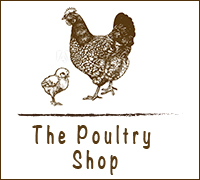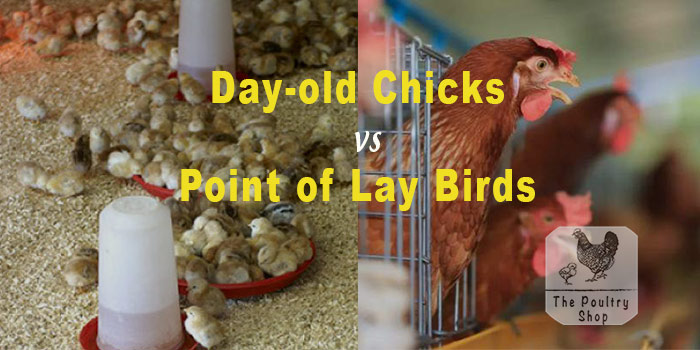Do you want to keep layer chickens but not sure whether to start with day-old chicks or buy point of lay birds?
You’re not alone…many new poultry farmers often face the same dilemma.
The good news is that both options work fine. Its largely a matter of personal preference and your individual circumstances.
In this article, I will try to cover the advantages and disadvantages of each option to help you make a decision.
Option 1: Day-old Chicks
This option involves the poultry farmer buying day-old chicks for keeping until the birds start laying eggs. Layer chickens usually start producing eggs around Week 18 or 19 although some chicken breeds take longer.
ADVANTAGES OF STARTING OFF WITH DAY-OLD CHICKS
1. Spreading Costs
If you do not have all the capital required to buy point of lay birds, feed, and vaccines, it makes more sense to start with day-old chicks. Point of lay birds on average cost US$8 and to start off with 100 birds, for instance, you need US$800 to cover cost for hens only. Many small scale poultry farmers may not afford this initial capital outlay.
Starting with day-old chicks offers one the flexibility to buy feed and vaccines as and when required. This can be a more practical option for those with limited capital. Raising day-old chicks until they reach the point of lay stage is also slightly cheaper as compared to buying point of lay birds.
2. Experience
Starting off with day-old chicks offers the poultry farmer an opportunity to learn and gain experience on rearing layer chickens. Watching the baby chicks grow can be a fulfilling experience too. As the birds grow, a mutual connection and trust is built between the poultry farmer and the birds which is very important with layer chickens.
3. Management Practices
Keeping day-old chicks allows the poultry farmer to have total control regarding vaccination schedules, feed quality, and ensuring the birds are raised under the best management practices.
This ensures a healthy flock is raised that lays good quality eggs. The poultry farmer will have the confidence that the birds have been raised under the best management practices.
4. Raising own specific breed
Some chicken breeds are hard to find at point of lay. The best option will be to buy chicks and raise the birds till maturity. For instance, there are few suppliers of good quality point of lay birds for breeds such as Kuroilers, Black Australorps, Rhode Island Red and Leghorns among others.
DISADVANTAGES OF STARTING WITH DAY-OLD CHICKS
1. Time Factor
It takes 6 months on average before layer chickens start producing eggs. For some, this may be too long a period to wait before they can start getting a return on investment.
2. Poor management practices
Failure to properly raise the day-old chicks to maturity in terms of brooding, feed, vaccines, and housing among others can result in prevalence of diseases, high mortalities, and poor egg production. After such a wait, this can be a disappointing loss.
Option 2: Point of Lay Hens
These are birds raised by other breeders and sold just before they are due to start laying. Most point of lay birds are sold at around Week 16 or 17.
ADVANTAGES OF BUYING POINT OF LAY HENS
1. Quick Return
Provided the birds were raised under good management practices, one should start picking eggs within two weeks after purchase. It’s always advisable to buy from reputable suppliers with a good track record to avoid huge losses and disappointments.
2. Cost of Production
There is a slight difference in terms of costs of raising day-old chicks and buying point of lay hens. Factoring the time spent on brooding and rearing chicks to maturity, some people often find the extra stress as unnecessary and hence the decision to start off with point of lay birds.
2. Low Mortality Rates
Point of lay birds are mature and more resistant to diseases hence have a lower mortality rate as compared to day-old chicks.
DISADVANTAGES OF BUYING POINT OF LAY HENS
1. High Initial Costs
For small-scale poultry farmers, buying point of lay birds, feed, and vaccines all at once may not be possible due to limited financial resources. Buying day-old chicks and spreading the costs over the next 6months may be the only viable option. To realise meaningful returns with layer chickens, one needs to start off with large numbers such as 100 birds and above. This may not be feasible with the option of buying point of lay birds.
2. Poor Flock Quality
This is one of the greatest risk of buying point of lay birds. If the supplier’s flock is of poor quality, egg production will also be low and hence a huge loss to one’s investment. Some suppliers do not feed or properly vaccinate their birds and coupled with a lack of proper records, this makes buying point of lay birds very risky.
3. Environmental Changes
Changes in the environment from supplier to new poultry farmer can result in egg production being affected or even mortalities being recorded. Diseases can also be imported resulting in extra costs to treat the sick birds. Change of feed also affects bird’s metabolism and egg production rate. In the event the birds fail to adapt to the new environment, this may result in losses to the new poultry farmer.
Conclusion
Personally I prefer to start off with day-old chicks and have the birds grow under my watch. What is your preference and why? Please post your feedback in the comment box below.



Hi sir.
I’m looking for start with day old chicks and buy feltilized eggs, how can I do? Have you this to sale, I’m now in Mozambique, but can organize logistics for Pick-up
For more details contact me on whatsapp +258870975512
very helpful information. thank you
Thank you for the helpful information
Hie.Thank you so much for the information. O want to start a Layers project at point of laying.I am looking for 100 of them.Where can I find them.
Thanks
Thank you… Very helpful
Your welcome Rachiel
Thanks for the guidline.i have just started brooding day old layer chicks.i have 300 chicks .I experiencd high mortality rate on the first two days ,went to the Vet and said it was dehydration even though I have plenty drinking containers.how best can I improve in keeping my day old chicks
Hi Amon,
1. I suggest you start with few numbers and master the basics and avoid losses. The experience is key and then you start increasing numbers later.
2. The issue might have been caused by stress from the time of collection to placement in the brooder. You should always ensure chicks get water mixed with stress pack the first 3-4days during the brooding stages. Whenever you collect chicks from the supplier, always ensure you hold each chick (one by one) and dip the beak into a shallow bowl of water mixed with stress pack. If a chick successfully takes a gulp (by holding its head up in the air), you can then release it into the brooder. Assisting chicks with the first sip or two helps to hydrate them quickly and it also teaches the ‘newbies’ the presence of water. Please ensure every chick gets access to water first before feed.
3. Ensure you use proper chick fonts or shallow bowls that allow the chicks to drink water comfortably.
Hope this helps, thanks.
How much are day old chicks on average
I have found this blog very useful! Thanks for the information.
Your welcome Tapiwa!
Helpful information. I am looking for someone to construct a fowl run to house 200 point of lay hens.
Thanks Theresa..any builder can assist. However, ensure the structure is open on 2 long sides to allow aeration, floor is hard and rough, house orientation is East-West (to avoid direct sunlight) and space allows for 8 birds per sqm, thanks.
I am sincerely grateful. You have guided me through proper management of poultry layers. Imeh Mfon
Am glad you found the information useful, all the best!
Thanx for the advices I’m interested in poultry but don’t know and how to start
Your welcome Zviko. Please stay tuned to this blog will cover many articles to assist you.
Hi Allen.
I am considering starting layers and am still investing in cages and feeds so that I have stocks first. Do you have a Whats App group that I can join to get more information. Please note, my email address is all in lower case not upper case.
Learning a lot here. Thanks!
However, I’d like to know the percentage difference in terms of costing; what could be the percentage difference in buying point of lay to raising day old chicks uptown point of lay?
Learning a lot here. 🙏
Thanks for the feedback.
Otiriachitsungo@gmail.com. I am in Zimbabwe a farmer for HYLINE point of lay. How best do I market my birds
Thank you Allen for sharing such valuable information.
Glad you found the article useful..
Great article. I prefer starting with the day old because one has total control over the management of the birds.
Thanks Charles for your feedback.
Where do you usually order your day old chicks… I always find this to be a problem. I want to raise day olds as I want to gain the experience but most reputable companies only offer point of lay and not day olds
Hi, I hatch roadrunner chicks (Black Australorps) at USD1 each. Booking is in progress for next batch to be available 9 August. You can raise these chicks to maturity and get table/fertilized eggs. If you need commercial layers that provide table eggs such as Hy-lines, kindly contact Zimavian or Irvines. Check the Classifieds and Business Directory sections on this website for their contact details, thanks.
Insightful!!!
Glad you found the article valuable Matios.
Very clear article, perfect for anyone wanting to venture into layers
Thanks Tashinga for the comment!